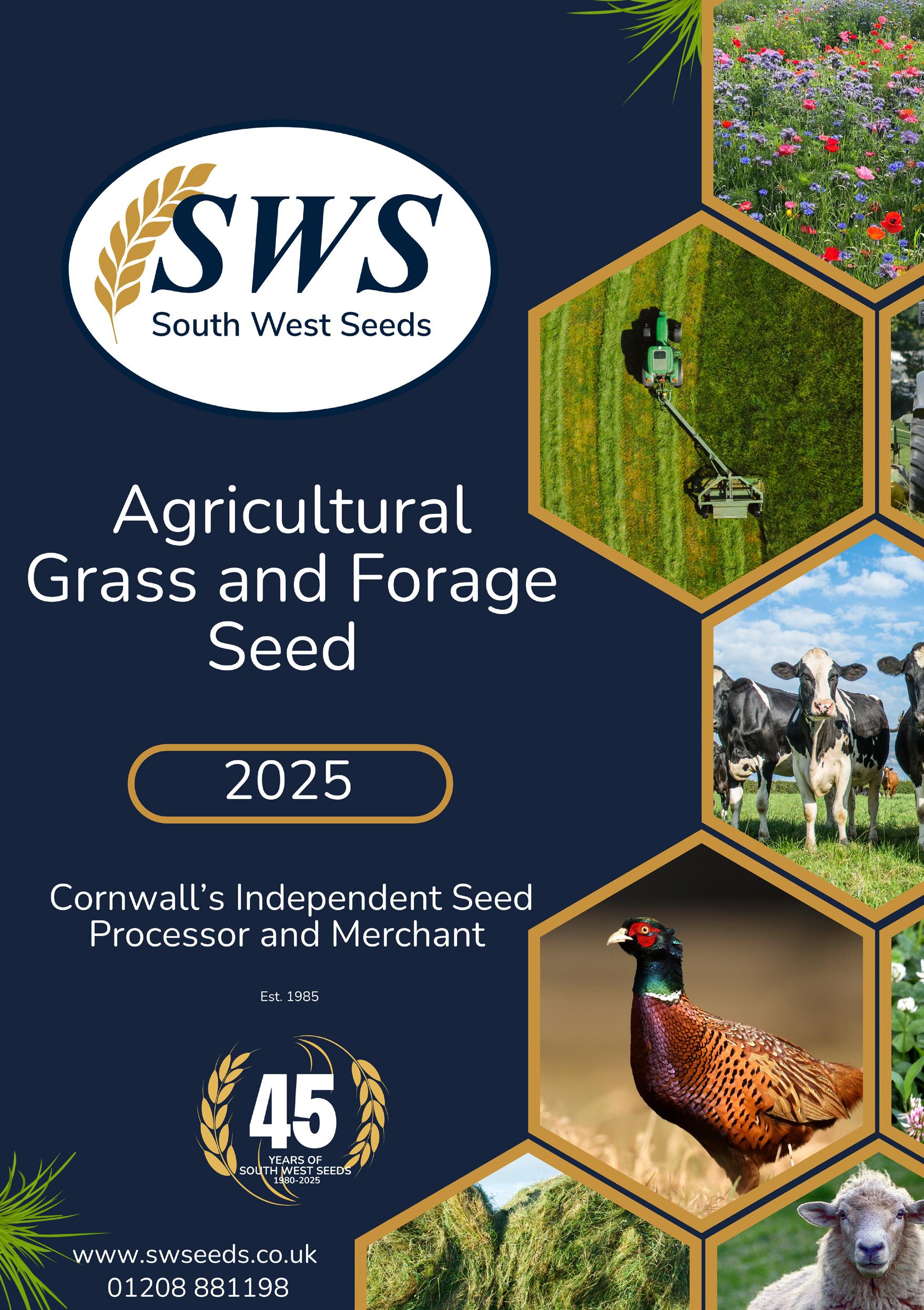
Why

Quality Service
45 years of experience



Friendly Advisors
Here to help
Delivery Included On all seed orders
Premium Products
A wide variety available







Why

Quality Service
45 years of experience



Friendly Advisors
Here to help
Delivery Included On all seed orders
Premium Products
A wide variety available





• The finest quality varieties selected for cutting and grazing regimes.
• 5+ year permanent flexible mixture, suitable for cutting and grazing.
• Very persistent and winter hardy.
• Spread of varieties to provide a balanced sward.
• Clovers selected for persistence, under long term dual purpose management.
• Timothy promotes early production and acts as a sweetener to the mixture.
• High protein levels and D-values from the clover and tetraploid grasses.
• Nitrogen fixing from the clover blend.
• We can add herbs to this mixture and the proportion of clover can be increased or decreased as required. Contact us for details.




• 3-4 year medium term dual purpose mixture giving high annual yield for both cutting and grazing regimes.
• Good sward density.
• Low soil temperature growth which gives it excellent winter hardiness.
• Nitrogen fixation from clovers.
• We can add herbs to this mixture and increase or decrease the amount of clover as required. Contact us for details.




• This mixture is designed to supply quality grazing with the potential of hay.
• Timothy in the mixture adds sweetness and ease of digestibility.
• The use of SSMG and Red Fescue keeps the bottom of the sward tight to help suppress weed competition and reduce damage by hooves.
• This mixture can be supplied with a herb mixture.
• Diploid varieties are used for lower sugar to prevent laminitis.
Mixture:
3.00kg Boyne INT DIP
4.00kg Agaska INT DIP
4.00kg Aston King Late DIP
1.50kg Comer Timothy 0.50kg Evora Smooth Stalk Meadow Grass
2.00kg Maxima 1 Creeping Red Fescue

Cutting and Grazing

15kg/Acre

March- September


Grass Mixture:
• A blend especially designed as a traditional Hay Meadow.
• Sold with or without the wildflower addition.
• The components are safe for grazing animals and for feeding the hay crop to stock.
• This mixture requires cutting late in the season to allow the seeds to shed.
• Do not allow thatch to build up in the bottom of the crop.
4.25kg Meadow Fescue
2.00kg Timothy 1.00kg Smooth Stalk Meadow Grass
1.00kg Rough Stalk Meadow Grass
1.00kg Crested Dogstail
0.50kg Meadow Foxtail
0.50kg Intermediate Perennial Ryegrass
0.50kg Late Perennial Ryegrass
0.50kg Cocksfoot
0.50kg Sheeps Fescue
0.50kg Tall Oat Grass
0.50kg Red Clover
0.25kg Yellow Oat Grass
Plus optional 0.75kg Wildflower Mixture:

10.0% Oxeye Daisy
10.0% Ladys Bedstraw
8.50% Common Knapweed
7.50% White Campion
7.50% Self Heal
7.50% Red Campion
5.00% Cornflower
5.00% Corn Marigold
5.00% Field Poppy
5.00% Small Burnet
5.00% Common Sainfoin
5.00% Yarrow
5.00% Yellow Rattle
3.50% Birdfoot Trefoil
3.00% Common Sorrel
2.50% Betony
2.50% Corn Chamomile
2.50% Field Scabious



March - September 13kgs/Acre (Grasses only) 13.75kgs/Acre (Grasses & Wildflower mix )

Mixture:
• Diverse mixture that gives a range of plants that produce large amounts of seeds.
• Can be sown as a single crop or mixed with a cereal crop, Triticale offering the best choice.
• Sow in strips at least 6 metres at the edge of the field or in blocks across the field.
20.00% Linseed (Flax)
18.50% Millet Blend (Red & White)
10.00% Fodder Radish
06.60% Quinoa Blend
11.60% Mustard 13.30% Rape Kale Hybrid
03.30% Phacelia
16.70% Sunflower Blend


1 Year Duration

8kgs /Acre

Spring or Autumn

Mixture:
• Highly recommended seed mixture.
• Allow time for all species to germinate.
• Productive and very high-quality forage.
• Reduces use of applied fertiliser.
• Preforms on most types of soils.
• Vigorous growth.
• Supplies food and habitat for invertebrates including crop pollinators.
• Use on arable and temporary grassland.
• Always keep records and photographic evidence of growth
2.70 kg Perseus Festulolium
1.10 kg Boyne PRG Int Dip
1.10 kg Calibra PRG Int Tet
2.00 kg Swan PRG Late Dip 2.00 kg Natasha PRG Late Tet
0.40 kg Barelite Tall Fescue
0.40 kg Comer Timothy
0.40 kg Maxima Smooth SMG
0.20 kg Altaswede Clover
0.30 kg Red Clover Blend
0.60 kg Ezzelina Lucrene Alfalfa
0.80 kg Restormel White Clover Blend
0.20 kg Birdsfoot Trefoil
0.45 kg Sheeps Parsley
0.45 kg Sheeps Burnet
0.50 kg Tonic Plantain
0.30 kg Fenugreek 0.10 kg Yarrow



14kgs /Acre 3 Year Duration

• 1-2 year low input mixture.
• Benefits include high protein and trace elements and will fix large amounts of atmospheric nitrogen for future cropping.
• The presence of perennial ryegrass with its prostrate habit fills out the bottom of the crop.
• Good disease resistance.

1-2 Years Cutting


• An ideal mixture to stitch into a damaged or worn out pasture.
• Tetraploids are more aggressive and establish more quickly than Diploid varieties.
• Ideally this mixture should be direct drilled or broadcast if the field has been cut low or grazed hard.
• Produces high sugars and has excellent ground cover.

1-3 Years


• Broad leaf perennial herb mixture.
• High protein clovers and tetraploid grass.
• Highley digestable and palatable.
• Rapid regrowth, don’t cut to close, leave at least 7-8 cm stubble.
• Chicory reduces internal parasites in stock. Mixture:
3.00kg Calibra INT TET
2.00kg Choice Chicory Herb
1.00kg Merula Red Clover

8kgs/Acre 2-3 years Grazing

1.00kg Diplomat Red Clover 1.00kg Dumnonia White Clover Blend

• Blended for damp soil conditions.
• This mixture is ideal for making hay or silage.
• Meadow Fescue and Timothy perform better than PRG in cooler, wetter soils.
• The palatable leafy regrowth of Meadow Fescue makes this mixture ideal for aftermath grazing.
• Timothy adds early growth to the mixture and with the late tetraploid adds sweetness to the crop.
• Red Clover adds protein and is nitrogen fixing.


14kgs/Acre

2.50kg Rusa HYB TET
also Available
• 3-4 year medium term dual purpose ley.
• Strong growth at low soil temperatures.
• High protein and D-value.
• Produces excellent silage.
• Suitable for grazing, silage and haylage.
• Deep rooted Festuloliums.
• Can provide 3-4 cuts per year.

Persuis Festulolium
Aston Vision INT TET


Nashota LATE TET
• Fast growing, hybrid mixture.
• Quick to establish with deep rooting grasses.
• Grows in most soil types and can be utilised in drier soils.
• Heavy yielding, lasting 3-4 cutting regimes.
• Option to add red clover to mixture.
• Fojtan is a Hybrid of Tall Fescue x Italian Ryegrass. 1.50kg Toddington LATE DIP

1-5 Years Dual Purpose 14kgs/Acre 3-4 Years Dual Purpose

Kendal LATE DIP

Mixture:
2.00kg Abyss HYB TET
3.00kg Agaska INT DIP
• Designed for full season production.
• Quality varieties producing maximum yields and palatability.
• Good disease resistance.
• The clover blend is suitable for all stock grazing.
• We can add herbs to this mixture and the proportion of clover can be increased or decreased to suit your requirements. Contact us for details.

3-4 Years Grazing
2.00kg Calibra INT TET 2.00kg Richie INT TET 1.50kg Toddington LATE DIP

Alamo IRG DIP 2.00kg Melsprinter IRG TET

14kgs/Acre
2.00kg Nashota LATE TET
0.75kg Rasant Timothy 0.75kg Dumnonia White Clover Blend
• 1-3 years high yielding silage mixture and grazing mixture.
• Establishes quickly. Benefits from Festulolium grasses.
• Responds well to high inputs.
• 3-4 good quality cuts can be expected.
• Mixture will grow in soils temperatures as low as 3 degrees C.
• A favourable mixture for drier soils.

Galgorm INT TET 4.00kg Cordial HYB TET

1-3 Years Silage and Grazing 2.00kg Lofa Festulolium TET 1.50kg Persius FestuloliumTET
13kgs/Acre

• Especially designed for intensive grazing systems.
• This mixture will provide a dense, persistent and productive sward giving excellent yield, quality and palatability.
• Provides production from early spring to late autumn.
• Do not overgraze in the first year - let the clover establish.
• We can add herbs to this mixture and the proportion of clover can be increased or decreased as required. Contact us for details.

5 +Years Grazing

15kgs/Acre
1.00kg Comer Timothy 1.00kg Dumnonia White Clover Blend

• High quality sheep and cattle grazing.
• Excellent mid to late summer production.
• Very palatable and recovers quickly from grazing.
• Clover enhances soil fertility. Allow the red clover to seed every 2-3 years.
• Creeping Red Fescue maintains a dense bottom to the mixture.
• We can add herbs to this mixture and the clover can be increased or decreased as
• required. Contact us for details.

5 +Years Grazing

15kgs/Acre
1.00kg Maxima 1 C Red Fescue
1.00kg Dumnonia W Clover blend 0.75kg Merula Red Clover
1.50kg Comer Timothy

• A highly palatable and persistent mixture which will establish well in cool, moist soils.
• Will out yield Perennial Ryegrass in wetter conditions.
• This mixture will produce good cuts of quality hay or silage.
• Also provides excellent productive grazing.
• Includes deep rooting species.
• We can add herbs to this mixture and the clover can be increased or decreased as required. Contact us for details
Years Dual Purpose

• Coarse grazing for beef and sheep.
• Can be utilised for a wide range of soil types.
• Enables high protien grazing all growing season
• Includes deep rooting species
• Graze frequently, top if necessary.
• Allow to seed every 2-3 years for the red clover.
• Can add herbs for a complete traditional sward.

+Years Grazing

March - September

Mixture:
4.00kg Aston Crusader Hybrid Tet
3.50kg Chatsworth Int Tet
1.50kg Boyne Int Dip
0.60kg Comer Timothy
• This mix has been specifically formulated to comply with the requirements for the SFI Sam3 scheme without losing any production. Whilst combining the benefits of varying root depths with the inclusion of the soft leaf tall fescue.
• Whilst perfectly suited to cutting or grazing, if using for a cutting mix then we would recommend the use of a silage inoculant to aid the preservation of the silage due to the high buffering capabilities of the Legumes.

Cutting or grazing
1.50kg Soft Leaf Tall Fescue
0.50kg Meadow Fescue
0.60kg Red Clover Mix

14kgs/Acre
0.50kg Alsike Clover
0.05kg Burnet
0.25kg Plantain
0.10kg Yarrow
0.75kg White Clover Mix (Med/large Blend)

Mixture:
2.50kg Cordial Hybrid Tet
2.25kg Kirial Hybred Tet
2.75kg Nolwen Int Tet
0.15kg Sheeps Parsley
• This mixture is perfectly suited for a Medium/Long term cut and graze mixture.The Red Clover will persist for up to 3 years in optimum conditions, and along side the white clover, it will fix a sensible amount of nitrogen for the grasses.
• The mixture contains mainly Tetraploid grasses for an increase in sugars, whilst also being a mix of strong hybrid and perennial grasses which will give fantastic yield for both cutting and grazing. The final addition of 2.5 kg of a Diploid will give it a good strong base.

15kgs/Acre 3-5 years Cut and Graze
2.00kg Galgorm Int Tet
2.50kg Nifty Int Dip

1.00kg White Clover Blend
2.00kg Red Clover Blend

South West Seeds is proud to have a long-standing relationship with Germinal. As a pioneering grass and forage breeder and supplier, Germinal has been supporting grassland-based businesses with 200 years of knowledge and expertise.
We are now excited to stock Germinal’s new Climate Smart mixture ranges which address five vital climate challenges impacting livestock farming. These innovative mixtures recognise that today, modern grassland farming demands the perfect balance of yield quality and environmental benefit delivering performance plus sustainability.
The mixtures include Germinal’s award-winning Aber High Sugar grass varieties, world leading hybrid clovers, multi-species biodiversity and soil health improvers and are available in cutting, grazing and dual-purpose options.
Germinal’s Climate Smart solutions have been expertly formulated and bring outstanding performance that allows you to produce food profitably while reducing your environmental impact.
Together, with best practice, these mixtures will support us in meeting net-zero targets.
Scientifically proven to reduce harmful emissions, Germinal’s Aber High Sugar Grasses enable the CLEAN range to offer superior forage performance while lowering harmful livestock emissions.
CAPTURE mixtures contain nitrogen fixing clovers that reduce the need for fertiliser applications, helping support the environment, livestock production, and cost control.
RESTORE is a dedicated range of government scheme-compliant mixtures for nature recovery. From clever clovers to healthy hedgerows, multi-species to meadows, all are expertly selected for forage performance with environmental benefits.
Boost soil fertility, structure and belowground biodiversity with THRIVE mixtures that enrich soil and reduce compaction to support and sustain healthy crop growth and yield.

Developed to support stressed pastures in extreme weather conditions, ADAPT mixtures contain tolerant varieties that can withstand a wider range of temperatures and drought conditions.





• Quick to establish with high protein.
• Ideal for fattening stock.
• Stock should be introduced gradually over a two week period and an area of grassland should be made available for the animals to return to.
• Sow April-September: provides grazing JulyDecember.
• This product is untreated.
2.25kg/Acre
April- September July- December
March - September

• Ideal for sowing after cereals.
• Good winter hardiness and very palatable.
• Stock should be introduced gradually over a two week period and an area of grassland should be made available for the animals to return to.
• Sow mid July-mid September, graze from late December onwards.
• This product is untreated.
2.25kg/Acre
July- Mid- September Late December Onwards
When grass crops are compromised during dry summers or cold winters, forage crops provide highly palatable alternative fodder. The crops are high in protein with low production costs, reducing the need to use expensive, bought in feed.
Stubble Turnip – Our favourite variety is Frisia. We have been using this versatile variety for many years as a straight or in our root mixtures. Large purple skin, white flesh and strap leaves. It sits high in the ground making it easy for feeding in situ or lifting and clamping. Sow at 2-3 kilos per acre.
Forage Rape - Short growing season 70-80 days with good yield of succulent leafy, highly digestible, protein rich forage. Best used as a catch or pioneer crop, Sow 2.5 – 4 kilos per acre, or as a nurse crop for new grass seeds @ 0.200 kg –0.300 kg per acre. Ideal for grazing sheep or cattle. This crop will require fertiliser incorporated at sowing and later applications. We are offering Akela as a stock variety which shows extremely high dry matter, vigorous growth and rapid establishment.

Fodder Beet – We can offer most varieties available in the UK with varying Dry Matter Content. From Brigadier (mangel type) 14.5% DM shallow rooted / small tops, to the variety Brick, which is 23.6% DM with deep roots and large tops. Sowing rate 45k – 50k seeds per acre.

Kale - This is a popular forage crop, quick to appear and establish in the field. It can be sown from April once soil temperatures have risen to 10-12 degrees. Sowing into cooler autumn soils is not recommended, early August is normally the latest time to sow. The crop is usually grown for cattle/sheep and grazed during the Autumn/ Winter period. We are majoring on the variety Inka which is a newer variety and classed as a giant Kale. Proteor, is an intermediate stem height variety and being a Marrow Stem Type is a dual purpose variety for both stock and game cover. Astera is suitable for cattle and sheep grazing being very winter hardy it also produces high crude protein yields. Sow 1 kilo per acre when direct drilling or 3 kilos per acre when broadcasting.
Root mixtures – These are high protein, winter hardy mixtures which extend stock grazing periods. Root mixtures use a balance of stubble turnip, forage rape and kale to create fodder either before Christmas (Early Sow) or in January or February March, (Late Sow).

Top Tip - check pH before drilling. Forage crops are very sensitive to low pH, (even a pH of 6, will reduce yields).
Root/ catch crop mixtures can be individually mixed to customers’ own requirements.

• Carbon (Mustard/Kale ) has red stems, which has a natural resistant to Flea Beetle.
• Carbon will give extremely quick cover and provide a seed source when sown early
• comparable in feed value to second year kale.
• New cover & feed mixture that includes a Kale mixture and Carbon.
• Kale provides excellent cover.




• Visually striking mixture that gives an excellent level of cover of varying heights.
• Produces huge amounts of seed from the majority of ingredients.
• Seeds produced are high in protein, especially from the Quinoa (14% protein).
• The Millet blend includes Red, White, Pearl & Japanese Reed Millet (great cover & seed source).




• Very quick to establish.
• Suitable for patching poorly established or damaged sowings.
• Can be broadcast directly into standing cereals or stubble for late cover.
• A very popular lifesaving rescue crop.
• Extremely fast to establish.
• Can be sown very late into the growing season and will last the season.




• We are now producing feed for game birds. Our standard mixture will be a wheat/cut maize/aniseeed mixture bagged in 25kg sacks.
• However, we are able to tailor the feed to suit your needs, by adding in or taking ingredients away.
• The mixture can also be suppllied in 500kg bags.
• Please call for enquiries.

£129/ ha annually
3 years
You must establish a multi-species cover crop on land entered into this action which will not be harvested as a ‘cash crop’. A ‘cash crop’ means a crop grown to be harvested for commercial use.
You must not do the following on the well-established cover crop:
• Mechanically apply any fertilisers or manures.
• Destroy it before the end of the winter months, unless you’re establishing an early-sown spring crop.

Excellent nitrogen fixing. Vigorous growth. Winter Hardy Vetches. Good weed suppressor.

12kgs/Acre

Cost effective. Very rapid growing. Excellent weed suppressor. Favourable soil conditioner. Excellent for holding nitrogen.

10kgs/Acre


Suitable for arable or stock farm.
Diverse cover crop designed with choice for grazing. Improves stock liveweight gain. High proteins. Palatable for stock.

7kgs/Acre
Mixture: 0.27kg Alsike Clover 0.27kg Crimson Clover 0.28kg Balansa White Clover 0.28kg Berseem Clover (Egyptian) 2.25kg Common Vetch 1.50kg Winter Vetch 0.30kg Stubble Turnips 0.50kg Forage Rape 0.70kg Fodder Radish
0.35kg Brown Mustard 0.30kg Phacelia
• Excellent for holding nitrogen.
• Incorporate to produce Bio Fumigation.
• Very quick growing annual cover crop. Do not let Phacelia flower.
• Nitrogen scavengers and deep rooting plants.
• Natural weed suppressing and soil conditioning.

4.5kgs/Acre
Mixture:
2.00kg Yellow Mustard 2.00kg Fodder Radish 0.50kg Phacelia
£163/ ha annually 3 years To minimise nutrient leaching, soil erosion and runoff
You must establish a multi-species cover crop mix during the spring and summer months (usually between March and May and June- August)
You must use a rapid growing seed mix that contains at least 4 species. This must include 2 species from two or more of the following plant families; Brassicas, Legumes, Cereals and Grasses, with grasses making up no more than 25% of the total mix by weight and herbs.
You must not:
• Cut it or graze it with livestock (other than when destroying the cover crop).
• Mechanically apply any fertilisers or manures.
• Destroy it more than 2 weeks before you intend to sow the next main crop.


• Fantastic weed suppressant.
• Excellent nitrogen fixer, nitrogen holder and soil conditioner.
• Has four species from three different plant families.

12kgs/Acre
Mixture: 6.00kg Lemnos 3.00kg Melsprinter
• Super fast establishment mixture.
• Balansa clover has long deep rooting tap roots and is a nitrogen fixer.
• Crimson clover is fast to establish and fixes large amounts of nitrogen.

4.5kgs/Acre
Mixture: 1.50kg Yellow Mustard 1.50kg Fodder Radish 2.00kg Balansa 1.00kg Crimsom Clover 0.50kg Phacelia 1.00kg Crimson Clover
Pay Duration Action’s Aim
£203/ ha annually 3 years
To reduce the risk of soil erosion and surface runoff
You must establish a quick growing cover crop as soon as possible after harvesting the maize crop, in time to establish before winter (this will usually be no later than around mid-October).
• You can graze the cover crop with livestock, but it must still be well-established over the winter months.
• Once the maize crop has been harvested, you must not apply fertilisers or manures to the winter cover crop during the autumn or winter months.
• If you’re establishing an early-sown spring crop, you may destroy the winter cover crop before the end of the winter months. You must not do this more than 6 weeks before you establish the earlysown spring crop.
• When you destroy the cover crop, you should try to minimise risks such as compaction, poaching, soil runoff or erosion.

• Super fast to establish.
• Ideal for sowing after maize.
• Reduces nitrogen leaching over winter.
• Improves fertility and soil structure.

16kgs/Acre
Mixture: 10.00kg Forage Rye
1.00kg Fodder Radish 5.00kg Westerwolds

£382/ ha annually 3 years To improve and maintain the soil’s structure, carbon, biology and fertility
If you’re establishing an herbal ley on land identified by you as being at risk of soil erosion or runoff, you must use establishment techniques which minimise the risk of soil erosion or runoff.
You must minimise use of inorganic fertilisers containing nitrogen. Usually, this will be no more than around 40 kilograms (kg) of nitrogen per ha per year. You must not use the established herbal ley for storage or apply pesticides on it, except:
• For herbicides to weed wipe or spot treat to control injurious weeds, invasive non-native species, or nettles or to destroy the existing ley to establish a new herbal ley.

CSAM3/ SAM3/GS4
and
• High legume content proving good summer cover and grazing.
• Supplies food and habitat for invertebrates including crop pollinators.
• Allow time for all species to germinate
• Productive and very high-quality forage
• Reduces use of applied fertiliser and performs on most types of soils.

12kgs/Acre
Mixture:
2.50kg Boyne PRG Int Dip
2.60kg PRG Late Dip
0.55kg Sparta Cocksfoot
0.80kg Laura Meadow Fescue
0.90kg Comer Timothy
0.50kg Swaj Tall Fescue
0.50kg Altaswede Clover 0.70kg Merula Red Clover

0.30kg Birdsfoot Trefoil
0.50kg Alsike Clover
0.60kg Lucerne Pre Innoculated Alfalfa
0.24kg Choice Chicory
0.36kg Sheeps Parsley
0.36kg Tonic Plantain
0.49kg Sheeps Burnet
0.10kg Yarrow
• Mixture uses grasses suitable for heavy wetter ground.
• Productive and very high-quality forage and reduces use of applied fertiliser.
• Abundant legumes and deep rooting herbs.
• Supplies food and habitat for invertebrates including crop pollinators.
• Use on arable and temporary grassland.

12kgs/Acre
Mixture:
2.10kg Laura Meadow Fescue
2.65kg Toddington PRG Late Dip
0.80kg Comer Timothy
1.00kg Lofa Festulolium
1.20kg Swaj Tall Fescue
1.00kg Merula Red Clover
0.40kg Aurora Alske Clover
0.25kg Yellow Blossom Sweet Clover
0.20kg Leo Birdsfoot Trefoil
0.40kg Alice White Clover
0.30kg Merlyn White Clover 1.00kg Common Vetch
0.11kg Choice Chicory
0.16kg Tonic Plantain
0.16kg Sheeps Parsley
0.22kg Sheeps Burnet
0.05kg Yarrow


CSAM3/SAM3/GS4 Herbal Diverse
• Diverse mixture of grass, legume and herb seeds that creates a multi-functional sward.
• Strong legume content to increase nitrogen production.
• Deep rooted mix that will improve soil structure.
• Species chosen to seek out micro-nutrients and moisture.
• Good grazing with medicinal benefits for livestock.
• Suitable for a wide range of soil types.

Mixture:
2.50kg Persius 1.50kg Sparta 1.00kg Laura 1.00kg Maxima
0.80kg Comer
1.00kg Kora
0.50kg Ezzelina Pre-Inoculated Alfalfa
0.75kg Red Clover
0.75kg White Clover
0.45kg Sainfoin
0.50kg Aurora Alsike
0.30kg Leo Birdsfoot Trefoil
0.15kg Choice Chicory
0.30kg Sheeps Burnet
0.22kg Sheeps Parsley
0.22kg Tonic Plantain
0.06kg Yarrow
• Good value option of the herbal diverse or heavy land herbal mixture.
• Wide range of species that gives a multifunctional sward.
• Beneficial to soil health and increases soil organic matter.
• Tolerant to disease and environmental stress.

Mixture:
3.00kg Merlin Festulolium 2.00kg Chatsworth PRG Int Tet 2.00kg Boyne PRG Int Dip
0.40kg Sparta Cocksfoot
0.40kg Laura Meadow Fescue
0.45kg Comer Timothy
0.50kg Red Clover Blend
0.30kg White Clover Blend
0.50kg Aurora Alsike Clover
0.08kg Choice Chicory
0.14kg Sheeps Burnet
0.10kg Sheeps Parsley
0.10kg Tonic Plantain
0.03kg Yarrow
£798/ ha annually 3 years
To provide habitat for invertebrates, including natural crop pest predators
You must establish a flower-rich grass mix as a margin, block or in-field strip on land entered into this action. You must use a seed mix which includes at least both:
• 4 grass species (not ryegrass) – these should make up no more than 90% of the total mix by weight
• 10 wildflower species – with no individual flower species being more than 25% of the total wildflower species element by weight
You must not:
• Cut or graze it with livestock in a way that means this action’s aim cannot reasonably be expected to be achieved.
• Use them for regular vehicular access, turning or storage (for example, storing bales or machinery)
• Mechanically apply any fertilisers and manures.
• Apply pesticides, except for herbicides to weed wipe or spot treat to control injurious weeds, invasive non-native species, or nettles.

CIPM2/ IPM2/AB8 Flower Rich Margins
• Provides a large amount of pollen and nectar rich plants throughout the year.
• Creates habitats for beneficial insects such as butterflies and hoverflies and farmland birds.
• Contains UK native wildflowers and low maintenance grasses.
• Includes 6 grass species and more than 20 species of wildflowers.
• Fits the criteria for IPM2 Flower Rich Margins and AB8 Flower Rich Margins. Organic also Available


• Cost effective.
• Very rapid growing.
• Excellent weed suppressor.
• Favourable soil conditioner.
• Excellent for holding nitrogen.

Mixture:
75.00% Buckwheat 25.00% Berseem Clover


Crop has vigorous growth. Inhibits weed growth. Annual companion for oilseed rape. Fixes nitrogen.
5kgs/Acre
Mixture:
70.00% Buckwheat 20.00% Berseem Clover

CIPM3/ IPM3 Lucerne / Sainfoin Grass Companion
• Companion mix to be sown alongside Sainfoin or Lucerne.
• Mixture improves soil structure and increases organic levels.
• Suppresses weeds.
• Provides extra forage.
• Fits criteria for IPM3 (SFI).

4kgs/Acre
Mixture:
2.00kg Laura Meadow Fescue 2.00kg Lischka Timothy

CIPM3/ IPM3 Maize Undersowing
• Satisfies criteria for IPM3 under SFI scheme.
• Reduces nitrogen run-off and soil erosion.
• Improves soil structure and organic matter levels.
• Fast growing and easy to establish.
• Improves soil moisture retention.

4kgs/Acre
£739/ ha annually
3 years To provide food for beneficial pollinators Pay Duration Action’s Aim
You must use a grass-free seed mix which includes at least 6 flower species, with no individual species being more than 50% of the total mix by weight.
The seed mix must include at least 2 of the following flower species:
• Common knapweed
• Musk mallow
• Oxeye daisy
• Wild carrot
• Yarrow
Once the pollen and nectar flower mix block or strip is established (usually from the second spring after sowing), you must maintain it.
You must not:
• Cut or graze it with livestock in a way that means this action’s aim cannot reasonably be expected to be achieved.
• Use it for regular vehicular access, turning or storage (for example, storing bales or machinery)
• Apply any fertilisers and manures.
• Apply pesticides, except for herbicides to weed wipe or spot treat to control injurious weeds, invasive non-native species, or nettles.

• Provides large amounts of pollen and nectar rich flowers from late Spring to Autumn.
• Attracts pollinating insects such as bumblebees and butterflies.
• Over 20 species of wildflowers in the mixture.

6kgs/Acre
• Suitable for most soil types. Mixture:
Alsike Clover
Birdsfoot Trefoil
Common Vetch
Merula Red Clover
Altaswede Red Clover (Late Flowering)
£853/ ha annually 3 years
To provide food resources for smaller farmland birds
You must use a seed mix which includes at least 6 small seed-bearing crops, which are suitable for smaller farmland bird species. The mix must not include:
• Artichokes
• Reed canary grass
• Giant and intermediate sorghum
• Maize
• Miscanthus
• Sweet clover
• Tic beans.
If you sow an annual mix, it can include a range of cereals, brassicas or other small-seeded crops. If you sow a 2-year mix, it can also include biennial crops such as kale, stubble turnip or teasel.
You must re-establish a 1-year mix annually and 2-year mixes every other year, so they continue to produce an extended supply of small seeds. This can be at the same location or a different location.
You must not: use the winter bird food mix block or strip for regular vehicular access, turning or storage (for example, storing bales or machinery).

CAHL2/AHL2/AB9 1 Year Winter Bird Food
• Annual mixture that will last 1 year.
• Provides a large selection of seeds for feed during autumn and winter for small birds and mammals.
• Attracts beneficial insects when flowering in the summer.
• Visually attractive and colourful from sunflowers and phacelia.
• Complies with CAHL1/AHL2 and AB9.

20kgs/Acre
Mixture: 60.00% Spring Triticale
Spring Barley
Linseed
Millet Blend 3.00% Fodder Radish
Quinoa Blend 3.50% Mustard 4.00% Rape Kale Hybrid 1.00% Phacelia 5.00% Sunflower Blend
CAHL1/AHL2 Mixtures


AHL2/AB9
• Winter bird food mix that lasts 2 years.
• Provides a large selection of seeds for feed during autumn and winter for small birds and mammals.
• Attracts beneficial insects when flowering in the summer.
• Visually attractive and colourful from sunflowers and phacelia.

20kgs/Acre
• Includes Kale and Chicory plus many seeds from brassicas in the 2nd year. Mixture: 60.00% Spring Triticale 10.00% Spring Barley 5.00% Linseed ( Flax) 5.00% Millet Blend 3.00% Fodder Radish 2.00% Quinoa Blend 2.20% Mustard 3.00% Stubble Turnip 4.20% Kale Blend 1.00% Phacelia
Choice Chicory 4.00% Sunflower Blend
CAHL2/AHL2/AB9 Late Sown Winter Bird Food
• Winter bird food mix suitable for sowing in the Autumn.
• Will attract beneficial insects when flowering such as bumblebees and butterflies.
• Phacelia provides good colour.
• Complies with AHL2 and AB9.

20kgs/Acre
Mixture: 11.00% Winter Barley (or Rye) 1.00% Rape Kale Hybrid 1.00% Late Flowering Fodder Radish 1.00% Akela Forage Rape 2.00% Gold of Pleasure (Camelina) 2.50% Linseed
Phacelia
Choice Chicory
Brown Mustard
Pay Duration
£590/ ha annually 3 years
Action’s Aim
To provide year-round habitat for a range of wildlife
To establish the grassy field corners or blocks you must either sow them or allow the areas to naturally regenerate. During the first 12 months after sowing them, or allowing them to naturally regenerate, you can regularly cut or graze them to:
• Control annual weeds
• Encourage new grass shoots to develop
You must not do the following on the grassy field corners or blocks once they’re established:
• Graze them with livestock in a way that means this action’s aim cannot reasonably be achieved.
• Cut them, except for localised cutting to control injurious weeds or invasive non-natives, soft and hard rush, or nettles.
• Use them for regular vehicular access, turning or storage (for example, storing bales or machinery).
• Carry out activities that may disturb breeding birds or damage nests, as birds, nests and eggs are protected by law.
• Apply any fertilisers, manures or lime.
• Use pesticides, except for herbicides to weed wipe or spot treat to control injurious weeds, invasive non-native species, or nettles.

Available in two options A & B. Quick to establish and for weed suppression. Highly suitable for margins and buffer strips around
Complies with SFI (AHL3 & 4).

Strong Creeping Red Fescue
Meadow Fescue
Agri Tall Fescue
Strong Creeping Red Fescue
Meadow Fescue
Chewings Fescue
£747/ ha annually 3 years To increase Biodiveristy & provide food for birds and insects Pay Duration Action’s Aim
You must establish a bumblebird mix as a block or strip on land entered into this action. You must use a seed mix which as a minimum includes both:
• 6 flower species
• 6 seed-bearing crops, with a maximum of 3 cereal crops from barley, oats, rye, triticale and wheat.
You must not apply pesticides, except for herbicides to weed wipe or spot treat to control injurious weeds, invasive non-native species, or nettles.



24kgs/Acre
Mixture:
8.00kg Spring Triticale
8.00kg Spring Wheat
1.20kg Millet Blend
0.40kg Fodder Radish
0.75kg Gold Of Pleasure
0.80kg Kale Blend 1.00kg Linseed (Flax)
0.25kg Alsike Clover 0.25kg Birdsfoot Trefoil 1.60kg Common Vetch
1.00kg Crimson Clover
0.25kg Lucerne (Pre-inoculate) Alfalfa 0.25kg Phacelia 0.25kg Red Clover Blend

24kgs/Acre
Mixture:
8.00kg Winter Triticale 8.00kg Winter Wheat 0.40kg Fodder Radish
0.75kg Gold Of Pleasure
0.80kg Kale Blend 2.00kg Linseed /Flax 0.25kg Alsike Clover
0.25kg Birdsfoot Trefoil 1.60kg Common Vetch
1.20kg Crimson Clover 0.25kg Lucerne (Pre-inoculated) Alfalfa 0.25kg Phacelia 0.25kg Red Clover Blend
£732/ tonne annually 3 years
To provide food to farmland birds when seed is in short supply
You must spread a winter supplementary feeding mix in a way that can reasonably be expected to achieve this action’s aim, including:
• Dividing the total weight of mix as equally as possible between the multiple feeding areas
• Spreading the mix at least once a week from over the winter until mid-spring in the following year (usually from early December to late April)
You must use a winter supplementary feeding seed mix that contains both:
• Cereals (not maize) – these should make up no more than 70% of the total mix by weight
• Small non-cereal seeds – these should make up at least 30% of the total mix by weight, with no individual species being more than 50% of the non-cereal element by weight The small non-cereal seeds element must contain at least 3 of the following species: canary seed, linseed, oilseed rape, red millet, sunflowers, white millet.
You must not:
• Use feed hoppers to supply more than around 10% of the seed mix during each feeding period (from later winter to mid-spring).
• Use tailings (small seeds and chaff removed from the harvested crops) in the seed mix.
You must keep a written ‘feeding diary’ which includes:
• Details of the mix used, including the weight of the cereals and small non-cereal seeds. elements and cost.
• Feeding dates.
• Method of feeding – spreading or hopper.
• Amount fed.
• Location of feeding areas.


24kgs/Acre
Mixture:
• Wheat
• White Millet
• Canary Seed
• Rape Seed
• Black Sunflowers
Price Per 1000kg 1 part seed mix to 2 parts wheat
£764 /ha annually
3 years
You must establish an in-field beetle bank by:
• Creating a raised earth ridge.
To provide nesting and foraging habitats for ground nesting species
• Sowing a mixture of fine-leaved grasses, such as red fescue, together with some tussock forming varieties like tall fescue, timothy and cocksfoot.
You can leave gaps of up to around 40m at each end of the beetle bank to allow machinery access.
Once the grassy mix on the beetle bank is established, you must maintain it in a way that can reasonably be expected to achieve this action’s aim.
You must not apply:
• Any fertilisers, manures or lime.
• Apply pesticides, except for herbicides to weed wipe or spot treat to control injurious weeds, invasive non-native species, or nettles.


8kgs/Acre
Mixture:
35.00% Cocksfoot
17.00% Tall Fescue
30.00% Strong Creeping Red Fescue
18.00% Timothy


8kgs/Acre
Cocksfoot
Tall Fescue
Strong Creeping Red Fescue
Aim
£489 ha annually 3 years To stabilise the soil, reduce nutrient losses and reduce risk of flooding
You must establish a diverse grass sward on land entered into this action. You must use a seed mix which includes at least 5 grass species.
Once the grass sward is established, you must maintain it. To do this, you must manage it in a way that can reasonably be expected to achieve this action’s aim. This includes:
• Making sure there’s an intact sward throughout the year, with minimal bare ground
• Grazing or cutting the sward during the spring and summer months, with cuttings removed in late summer after the bird breeding season
You must not:
• Graze it with livestock during the autumn and winter months (usually from early October until midMarch).
• Apply pesticides, except for herbicides to weed wipe or spot treat to control injurious weeds, invasive non-native species, or nettles.
• Apply any fertilisers or manures from late summer until mid-winter (usually from mid-August until the end of January) – this is to reduce the risk of runoff
• Apply any livestock manures with 100 kilograms (kg) or more of total nitrogen per ha per year.



14kgs/Acre
Mixture:
2.50kg Pardus Meadow Fescue
2.50kg Liherold Meadow Fescue
2.00kg Comer Timothy
2.00kg Swaj Tall Fescue
1.00kg Bornito Hard Fescue
3.00kg Maxima Strong Creeping Red Fescue
0.50kg Evora Smooth Stalked Meadow Grass
0.15kg Southlands Crested Dogstail
0.10kg Meadow Foxtail
0.10kg Dasas Rough Stalked Meadow Grass
0.15kg Highland Common Bentgrass

14kgs/Acre
Mixture:
3.00kg Laura Meadow Fescue
2.50kg Liherold Meadow Fescue
3.75kg Persius Festulolium
2.00kg Comer Timothy
2.25kg Evora Smooth Stalked Meadow Fescue
0.25kg Solo Rough Stalked Meadow Grass
0.25kg Crested Dogstail




A very colouful wildflower mixture that can be sown in the spring or autumn and takes little maintenance. Seed can be sown directly on to bare ground or into existing flower mixture.
All mixtures can be offered as either 100% wildflowers, or mixed with grass, usually at a ratio of 20:80 wildflowers to grass. For more information please visit our website.
A blend of colourful annual and perennial wildflowers. This mixture will grow in most soil types and is designed for low maintenance. Sow in the spring or autumn.
All mixtures can be offered as either 100% wildflowers,or mixed with grass, usually at a ratio of 20:80 wildflowers to grass. For more information please visit our website.
This mixture is ideal for lowland meadows, damp or seasonally wet soils. Sow 100% for small areas. For larger areas sow with a grass companion with the grass being 80%. This mixture will flower from spring to late autumn.
All mixtures can be offered as either 100% wildflowers,or mixed with grass, usually at a ratio of 20:80 wildflowers to grass. For more information please visit our website.
Flowers are suited to full and dappled shade. Offers well scented species. This mixture offers colour amongst the trees from spring until autumn. Thrives in old and young woodland.
All mixtures can be offered as either 100% wildflowers,or mixed with grass, usually at a ratio of 20:80 wildflowers to grass. For more information please visit our website.




For areas of low pH values such as heathland and moorland heathers, this mixture offers an excellent blend of high nectar flowers complementing the local flora. Sow 100% in small areas or with grass companion for larger areas.
All mixtures can be offered as either 100% wildflowers , or mixed with grass, usually at a ratio of 80:20 grass to wildflowers. For more information please visit our website.
Mixture is best suited to lowland meadow grassland and is of value to many different species of bees, hoverflies, beetles and butterflies plus many more insects.
All mixtures can be offered as either 100% wildflowers , or mixed with grass, usually at a ratio of 80:20 grass to wildflowers. For more information please visit our website.
General purpose seed mixture. This mixture includes a large selection of nectar giving flowers with a varied colourful display. Suitable for bees, hoverflies, butterflies and other wildlife. Sow as pure seed for small areas and for larger areas we would suggest mixing with a grass companion.
All mixtures can be offered as either 100% wildflowers , or mixed with grass, usually at a ratio of 80:20 grass to wildflowers. For more information please visit our website.
Suitable for a wide range of soil types ranginng from 5.0-6.5 pH. This mixture offers a diverse blend of flowers and colour and benefits bees, hoverflies, butterfiles and other species of wildlife.
All mixtures can be offered as either 100% wildflowers , or mixed with grass, usually at a ratio of 80:20 grass to wildflowers. For more information please visit our website.




• Low maintenance.
• Incredible fine finish if rolled it will leave a superb striped effect.
• This mixture does not tolerate heavy footfall.
• Optimum pH 5-6.
• Grows on a wide range of soils.
• Excellent all year colour.

• A tough durable mixture withstanding constant & heavy footfall.
• Includes grass that strengthens the lawn and helps establishment.
• Quick to recover.
• Easy to maintain.
• Ideal for back or front lawn.
• Requires a fine,firm seedbed.

• Ideal for parks, verges, playing fields etc.
• Works well under constant use and lots of wear.
• Quick to establish and recover.
• Highly economic mixture.

• Easy to maintain - dense bottom to the mixture.
• Fast to recover from heavy wear and tear.
• Hardy and less prone to drought.
• Nitrogen fixing clovers.
• Hardy blend mixture.
• Can be cut as low as a lawn.
• Good disease resistance.

2 sets of chromosomes. Perennial diploids have a prostrate growth habit, filling the bottom of the ley.
4 sets of chromosomes. Higher yielding, higher D value, larger leaves with increased sugar content and more.
An annual Italian Ryegrass. Establishes quickly, produces a large bulk and can be cut several times. Do not let it go to seed head.

Fast growing, economical 2-3 year grass. For best results use 50% Diploid/ 50% Tetraploid.
Classified into 3 categories: Early, Intermediate & Late depending on heading date.
Biological cross of Italian and Perennial Ryegrass. Combines persistency of Perennial and earliness and productivity of Italian. Used in medium term mixtures, lasting 3-4 Years.
Hybrid cross of either Italian or Perennial Ryegrass and either Meadow Fescue or Tall Fescue. Fescues add winter hardiness, persistence and stress tolerance and are deep rooting. Digestibility and sugar levels from Ryegrasses.


Highly palatable tussock grass. Non-aggressive, winter hardy and slow to establish.
Suited to cool damp soils, with plenty of early production.
Deep rooting copes well with cool damp conditions and dry conditions.
Upgraded yield potential in modern varieties.


Best suited to grazing on dry sandy soils producing excellent grass production.
Management required, as the leaves develop barbs becoming unpalatable if left to grow too tall.

Nitrogen fixing roots. Good for smothering weeds.
High in protein, lasting between 3 and 4 years.

Deep rooting prevents soil erosion.
Helps with health and liveweight gain in ruminants.
Anti-oxidising, helping with indigestion in horses.
Prefers light soils and is drought resistant.
High in Iron and Vitamin C. Comes to seed head in second year.

Collects Nitrogen from the air, distributing to nearby plants through the rooting system within a few months.
Small leaved clovers suit grazing mixtures, large leaved clovers suit silage mixtures,competing with

Large tap root drawing minerals and trace elements from the soil.
Rich in Magnesium, Calcium and Phosphate.
Prevents diarrhoea in sheep.
As it’s invasive, sowing too much can be negative to the sward. Manage through grazing aggressive grasses.

Suits most soils types. High in minerals, especially Copper and Selenium. Increases milk and meat production in sheep and cattle. Reduces effects of internal parasites, increases daily liveweight gain and is very palatable.
Nitrogen fixing and improves soil structure. Winter Hardy and high protein content.
Early and rapid establishment



High in minerals including Zinc,Potassium and Copper. Helps reduce effects of internal parasites. Good tolerance to drought, acidic soils and major pests. Do not allow crown to be taken out (mowing or grazing). Don’t let it go to flower, it will become toxic and sour.
Perennial legume suiting limestone, chalk and stony soils. Doesn’t perform well on heavy soils or anything with a pH less than 6.2.
Nitrogen fixing legume which won’t bloat animals and is methane suppressing. Produces more Nitrogen than white clover, but only lasts 3-4 years. Do not overgraze or mow too low (between 5-10cm) – it requires six weeks to recover.
Renowned for its slow establishment

High yielding protein forage with low energy levels.
Nitrogen fixing with long tap roots. Up to 4 cuts a year over 5 years. Can cause bloat in grazing stock. Suited to sandy/free draining soils as it searches out moisture.




















Have you seen? Our Amenity Grass Seed & Fertiliser Brochure?







Lawn Seed Mixtures
Golf Course & Sports Mixtures
Equestrian Mixtures
Wildflower Seed
Scan the QR code to view our full Amenity range on our website!

Fertiliser
Plus much more!





“ We have been using South West Seeds for many years and are extremely pleased with the quality of grass leys. We have received very good advice on seed selection from a seedsman rather than a salesman.”


“ The seed arrived very quickly and I cannot fault the level of service received. The All Seasons Maize seed grew well. I shall definitely be using South West Seeds this year and may look to experiment with bespoke mixtures.”

“Very good! I was unsure of which grass seed to buy so I asked the question via email. I recieved a swift and very helpful reply. Placed an order which arrived safely. Thank you!”

“A great mix of grasses and clover produced a lovely hay crop this spring and survived the drought and is still producing a thick sward”
( Regal Grass Mixture. p4)

“The 4-year Cut & Graze mix is very high yielding combination that establishes quickly and grows well in cooler conditions... Cut & Graze maintains good production in a cycle of 4 year grass and 4 years cereals on our farm in the Blackdown Hills”
